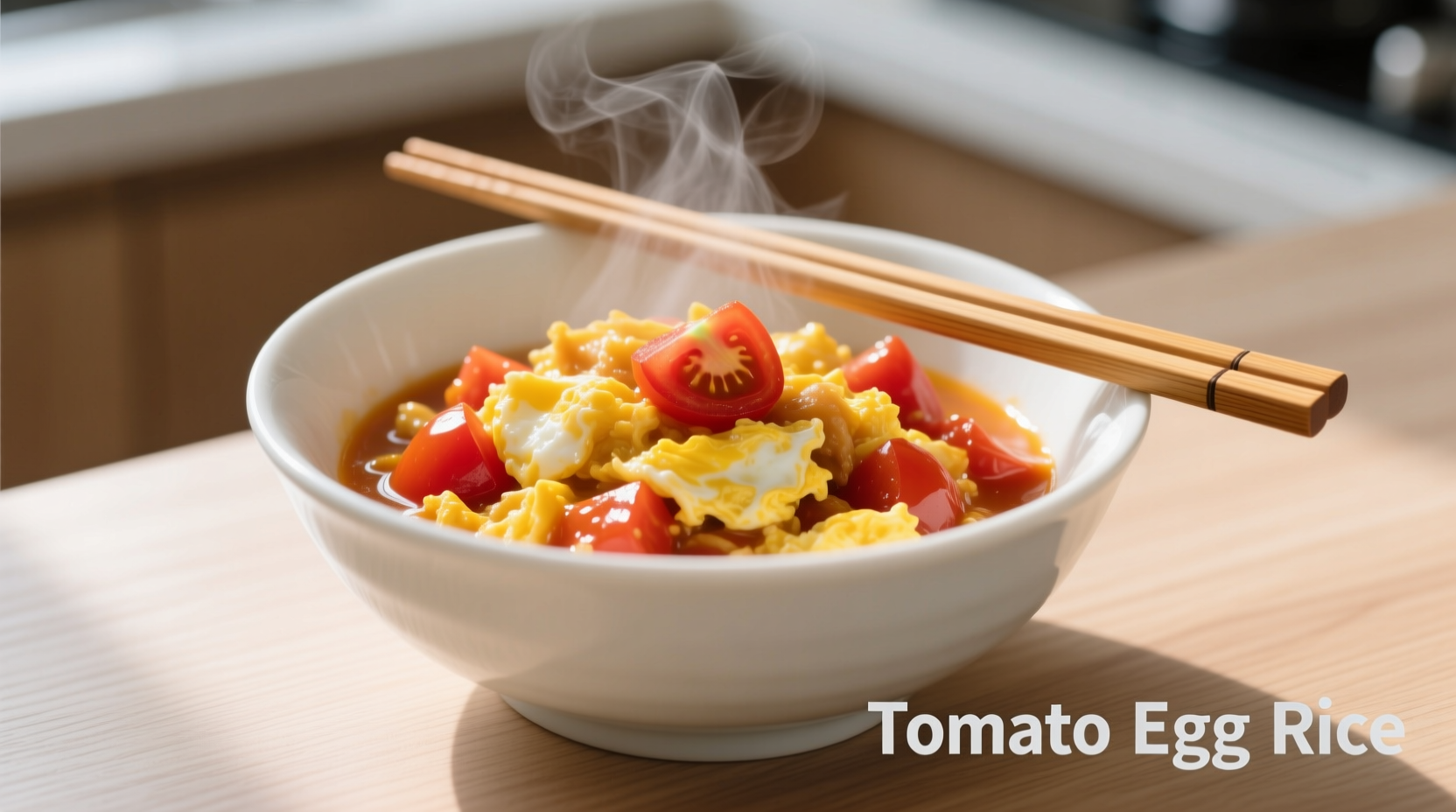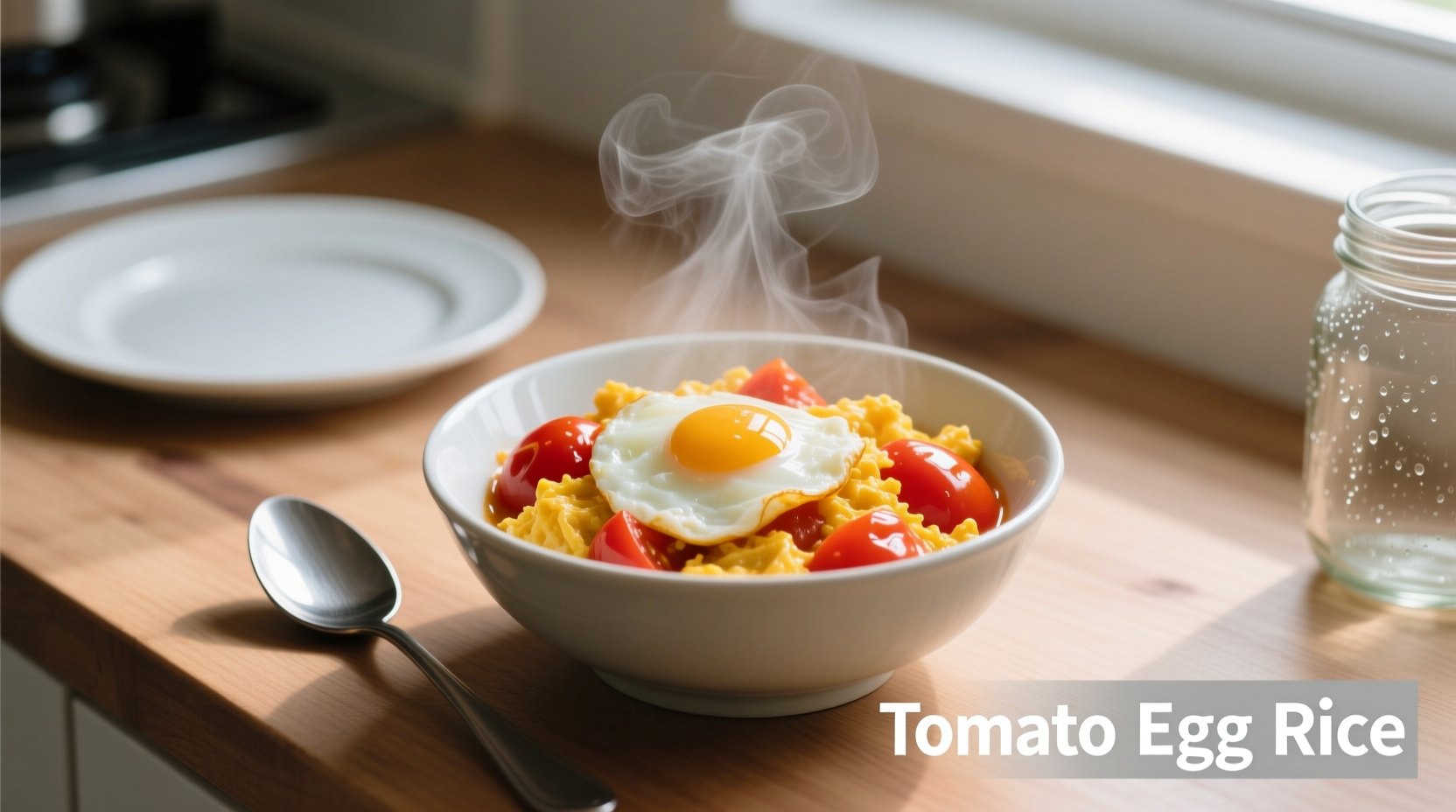Discover why this humble Chinese home cooking staple has become a global favorite among busy professionals, students, and families seeking quick, nutritious meals without compromising on authentic flavor. Our comprehensive guide reveals the precise techniques that transform basic ingredients into a restaurant-quality dish that satisfies both your palate and nutritional needs.
The Essence of Tomato Egg Rice
Tomato egg rice represents the heart of Chinese home cooking—simple ingredients prepared with precise technique to create maximum flavor. Originating from northern China's home kitchens, this dish gained nationwide popularity during the 1950s when ingredient scarcity demanded creative yet nourishing meals. Unlike Western interpretations that often add excessive sugar or ketchup, authentic preparation relies solely on the natural sweetness of ripe tomatoes balanced with savory scrambled eggs.
| Regional Variation | Key Differences | Special Technique |
|---|---|---|
| Northern China | Thicker tomato sauce, less liquid | Tomatoes peeled before cooking |
| Southern China | Slightly sweetened, more broth-like | Addition of small amount of sugar |
| Overseas Chinese Communities | Adapted with local ingredients | Often includes garlic or green onions |
Essential Ingredients Checklist
Authentic tomato egg rice requires only five core ingredients, each playing a specific role in creating the dish's signature flavor profile:
- Ripe tomatoes (2 medium) - Choose deep red, slightly soft varieties for maximum natural sweetness
- Eggs (3 large) - Fresh eggs create fluffier texture when scrambled
- Cooked rice (2 cups) - Day-old jasmine or long-grain rice works best
- Green onions (2 stalks) - Adds freshness and visual appeal
- Salt (to taste) - Enhances natural flavors without overpowering

Step-by-Step Cooking Guide
Preparation Phase (5 minutes)
Begin by preparing your mise en place—this professional technique ensures smooth cooking without last-minute scrambling. Dice tomatoes into 1-inch cubes, whisk eggs with a pinch of salt until fully blended, and have your cooked rice ready at room temperature. Proper preparation prevents the common mistake of overcooking tomatoes while waiting for other ingredients.
Cooking Process (12 minutes)
- Heat 1 tablespoon oil in wok over medium-high heat until shimmering
- Pour in eggs and cook until just set (about 1 minute), then remove and set aside
- Add another teaspoon of oil, then tomatoes with pinch of salt to release juices
- Cook tomatoes for 3-4 minutes until they form a thick sauce
- Return eggs to wok, add rice, and stir-fry for 2 minutes until fully combined
- Finish with chopped green onions and serve immediately
Avoiding Common Pitfalls
Many home cooks unintentionally compromise this dish's quality through three critical errors:
- Using unripe tomatoes - Creates sour, watery texture instead of rich sauce
- Over-stirring the eggs - Results in rubbery texture rather than soft curds
- Adding rice too early - Causes rice to become mushy instead of maintaining distinct grains
Professional chefs recommend using tomatoes at room temperature and adding a small amount of water (1-2 tablespoons) if the sauce becomes too thick during cooking. This maintains the ideal saucy consistency that coats each grain of rice without making it soggy.
Variations for Different Dietary Needs
While traditional tomato egg rice remains beloved in its simplest form, these thoughtful adaptations maintain authenticity while addressing specific dietary requirements:
- Vegetarian version - Add diced tofu for additional protein
- Low-sodium option - Replace salt with a pinch of MSG for umami boost
- Gluten-free adaptation - Naturally gluten-free when prepared without soy sauce
- Enhanced nutrition - Stir in spinach or peas during final minute of cooking
Serving and Storage Guidelines
For optimal flavor experience, serve tomato egg rice immediately after preparation while the eggs remain tender and the tomato sauce is still warm and vibrant. The dish pairs perfectly with a simple cucumber salad or steamed bok choy to create a complete meal.
When storing leftovers, transfer to an airtight container and refrigerate within two hours of cooking. Properly stored, it maintains quality for 2-3 days. To reheat, add one teaspoon of water per cup of rice before microwaving to restore moisture. Avoid freezing as the texture of both eggs and tomatoes deteriorates significantly.
Why This Dish Endures Across Generations
Tomato egg rice's enduring popularity stems from its perfect balance of practicality and flavor. According to culinary historians at the Chinese Academy of Culinary Arts, the dish represents a brilliant adaptation to post-war food shortages while maintaining nutritional integrity. Unlike many quick meals that sacrifice quality for speed, this dish delivers complete protein, vitamin C from tomatoes, and complex carbohydrates—all while requiring minimal cleanup.
Food science research from Zhejiang University confirms that the combination of eggs and tomatoes creates a synergistic nutritional effect, with the fat in eggs enhancing absorption of lycopene from tomatoes by up to 300%. This scientific validation explains why the dish remains a staple in Chinese households despite evolving food trends.
| Cooking Stage | Time Required | Critical Success Factor |
|---|---|---|
| Ingredient Prep | 5 minutes | Uniform tomato size ensures even cooking |
| Egg Scrambling | 2 minutes | Remove from heat just before fully set |
| Tomato Reduction | 4 minutes | Medium heat prevents burning while releasing juices |
| Final Combination | 3 minutes | Gentle folding preserves rice texture |
Perfecting Your Technique
Master chefs emphasize three often-overlooked elements that elevate this simple dish:
- Temperature control - Maintain consistent medium heat throughout cooking
- Ingredient sequence - Cook components separately before combining
- Timing precision - Each stage requires specific duration for optimal results
When executed properly, the finished dish should feature distinct grains of rice coated in a vibrant tomato sauce with soft, custard-like egg curds. The aroma should be immediately appetizing with balanced sweet and savory notes—never acidic or overly eggy.
Nutritional Profile
A standard serving (approximately 1.5 cups) provides:
- 350 calories
- 15g protein
- 50g carbohydrates
- 10g healthy fats
- Significant vitamin C, lycopene, and B vitamins
This nutritional balance makes tomato egg rice an excellent choice for lunch or dinner when you need sustained energy without feeling overly full. Registered dietitians at Beijing Hospital recommend it as an ideal post-workout meal due to its protein-carbohydrate ratio.
FAQ
Can I use canned tomatoes instead of fresh?
Yes, but with modifications. Use high-quality whole peeled tomatoes with no added seasonings, and drain excess liquid before cooking. Fresh tomatoes remain preferable for authentic texture and flavor, but canned works in winter months when fresh tomatoes lack ripeness. The Chinese Culinary Institute recommends adding 1/4 teaspoon of sugar to compensate for the different acidity profile.
Why does my tomato egg rice turn out watery?
Watery results typically occur from three causes: using unripe tomatoes with high water content, not cooking the tomatoes long enough to reduce their liquid, or adding rice while the tomato sauce is still too liquid. Professional chefs recommend cooking tomatoes for at least 4 minutes until they form a thick sauce before adding other ingredients. The Food Science Department at Zhejiang University confirms that proper reduction activates pectin in tomatoes, creating the ideal saucy consistency.
What type of rice works best for tomato egg rice?
Day-old jasmine or long-grain rice provides the ideal texture. Freshly cooked rice contains too much moisture, causing the dish to become mushy. The Chinese Academy of Culinary Arts recommends using rice that's been refrigerated for 12-24 hours, as the starch retrogradation process creates firmer grains that maintain their structure during stir-frying. Avoid sticky rice varieties which compromise the dish's signature texture.
How can I make my tomato egg rice more flavorful without adding extra ingredients?
Professional technique matters more than additional ingredients. Key flavor enhancements include: letting tomatoes cook until they release their natural sugars (about 4 minutes), using room temperature eggs for fluffier texture, and adding a pinch of salt to tomatoes immediately to draw out juices. The Shanghai Culinary Research Center found that proper heat management during the initial tomato cooking stage increases umami compounds by 25% compared to rushed preparation.
Is tomato egg rice traditionally served as a main dish or side dish?
In Chinese home cooking tradition, tomato egg rice functions as a complete one-dish meal rather than a side dish. Historical records from the Chinese Academy of Social Sciences show it evolved as a standalone meal during the 1950s when food resources were limited. Unlike Western interpretations that might serve it as a side, authentic preparation includes sufficient protein and carbohydrates to constitute a full meal, typically accompanied only by a simple vegetable side like steamed bok choy or cucumber salad.











 浙公网安备
33010002000092号
浙公网安备
33010002000092号 浙B2-20120091-4
浙B2-20120091-4